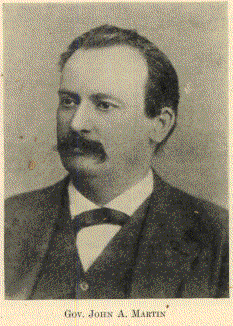| 1918 KANSAS AND KANSANS | Chapter 56 | Part 1 |

Gov. JOHN A. MARTIN
[Copy by Willard of Portrait in Library of Kansas State Historical Society]
John A. Martin, tenth Governor of Kansas, was born at Brownsville, Fayette County, Pennsylvania, March 10, 1839. He received a fair education in the common branches, and in his youth perfected himself in the printer's art. In 1857 he was in the office of the Commercial Journal at Pittsburgh. During the fall of that year he came to Kansas, a boy of only 19 years. But his experiences in the early days tended to make him a man in courage and intelligence in everything but years.
Martin worked a few months in the office of the Squatter Sovereign at Atchison, and then entered the service of James Redpath as a compositor on the Crusader of Freedom. In the fall of 1858, he purchased the Squatter Sovereign and changed its name to the Freedom's Champion. This newspaper he conducted till the day of his death, and its columns were always devoted to the cause of the oppressed. Later, the name of the paper was again changed, this time to the Atchison Champion.
Martin was a fervent Free-State man, and an enthusiastic Republican. Kansas was quick to see the value of such a man, and in 1859 Martin was elected Secretary of the Wyandotte Constitutional Conventionan - an honor and responsibility coveted by much older men. This was before he was twenty-one years old. He served as a delegate to the Territorial Convention of 1860, at Lawrence, and later in that year was sent to the Chicago National Convention. In 1859 he was elected State Senator from Atchison and Brown counties. Thus he was a member of the First State Legislature.
In the summer of 1861 Martin helped organize the Eighth Kansas Infantry, of which he was appointed Lieutenant-Colonel. He served on the Missouri border during the fall and winter of 1861. In 1862 he was made Provost-Marshal of Leavenworth, and he went in command of his regiment to Corinth in March of that year.
Colonel Martin fought gallantly all through the Civil War. He was with four great armies during that time - the Army of the Frontier, the Army of the Mississippi, the Army of the Ohio, and the Army of the Cumberland. He was present at the battle of Missionary Ridge, where his heroic fighting was as gallant as in his numerous other battles. Soon after being mustered out, at the close of the war, he was brevetted Brigadier-General, for gallant and meritorious service.
Colonel Martin always retained his love for his old comrades and was always certain of their unfaltering loyalty. He was the first Department Commander of the G. A. R. in Kansas, and was always active in any service for the veterans. The Soldiers Orphans Home at Atchison was in a great measure due to his labors. In 1878 he was appointed on the Board of Managers of the National Soldiers' Homes.
On June 1, 1871, he married Miss Ida Challis. Seven children were born to them.
In 1884 Colonel Martin was elected Governor of Kansas, and in 1886 he was re-elected. The beginning of his administration was very difficult, and he was besieged by hordes of office-seekers. This, on account of the previous Democratic administration.
At first, Governor Martin was not a prohibitionist, but in time, as he saw the beneficial effects of prohibition, he became converted to be one of its most ardent champions. During Governor Martin's administration six educational institutions were established in Kansas, and 182 school houses were built in 1887. Also, the State Reformatory was located at Hutchinson, and opportunities for reform were provided for young law-breakers. During this administration, The Annals of Kansas, a compilation of Kansas history extremely valuable, was written and published by D. W. Wilder.
In March of 1886, a strike and serious disturbances on the Missouri-Pacific Railroad, in Missouri and Kansas, demanded the attention of Governor Martin. Rioting caused the Governor to send the First Kansas Militia to the scene of action. After being the cause of great inconveniences and suffering, the strike was settled in April.
A bill was passed by the Legislature of 1887, conferring on women of Kansas the right to vote at school, bond, and municipal elections. This was one of the first steps toward the complete suffrage the State enjoys today.
Kansas had steadily progressed in prosperity and her towns and broad farming lands had increased immensely in value. This led to a "Boom" during which magnificent cities were erected - on paper - real towns increased in size. Many syndicates were organized to deal in Kansas real estate. Long blocks of buildings were erected in unnecessary towns, and the prairie was long after dotted with rusting pipes and hydrants - the only tangible evidences of these useless towns. The end of 1888 saw the great Kansas "boom" collapse, and, as this year had also had a failure of crops, Kansas experienced a panic. But this check in prosperity was comparatively brief.
There was a contest for the county seat between towns in several counties. Bitter rivalries and feuds resulted, the worst being the Stephens County, where several people were killed. On an appeal made to the Governor for help, a regiment of militia was sent to this county. In 1888 Greeley County was organized, thus completing the organization of the 105 Kansas counties.
At the expiration of his term as Governor, Colonel Martin returned to Atchison and resumed his work on the Champion. But in less than a year he was stricken by a fatal sickness. He died at Atchison October 2, 1889. He was buried, at his request, in the uniform he had so nobly worn in life.
| 1918 Kansas and Kansans | Previous Section | Next Section |
A Standard History of Kansas and Kansans , written and compiled by William E. Connelley, transcribed by Carolyn Ward, 1998.
